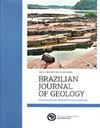巴西东北部沿寒武系走滑断裂前寒武纪地体重建:巴伊亚州地球动力学演化与金矿成矿新模式
IF 0.9
4区 地球科学
Q3 GEOSCIENCES, MULTIDISCIPLINARY
引用次数: 10
摘要
巴西东北部前寒武纪基底是Rhyacian地块辐合作用的产物。地壳花岗岩类的主要变形和侵入发生在2.15 ~ 1.8 Ga之间。在寒武纪期间,这一大片地区遭受了长期而相当均匀的压力。巴伊亚金矿省是不同构造热事件的成矿产物。金矿成矿分别发生在古元古代碰撞期和寒武纪辐合期,并伴有热流、地壳变形和花岗岩侵入。根据扭断构造假说,重建了该区约700 Ma前的构造格局。新的假设提供了地质证据和成矿约束,为进一步的研究提供了必要的依据,并参考了成熟的本文章由计算机程序翻译,如有差异,请以英文原文为准。
Reconstruction of Precambrian terranes of Northeastern Brazil along Cambrian strike-slip faults: a new model of geodynamic evolution and gold metallogeny in the State of Bahia
The Precambrian basement of Northeastern Brazil is the product of Rhyacian block convergence. The main deformation and intrusion of crustal granitoids occurred between 2.15 and 1.8 Ga ago. This large area has been subjected to long-lasting and rather uniform stresses during the Cambrian period. Gold provinces in Bahia represent metallogenetic products of distinct tectonothermal events. Gold mineralization took place during the Paleoproterozoic collision and the Cambrian convergence, respectively, accompanied by heat flow, crustal deformation, and granite intrusion. The tectonic framework of the region was reconstructed at ca. 700 Ma ago, considering the hypothesis of wrench-fault tectonics. The new hypothesis provides geological evidence and metallogenic constraints that make further investigation necessary, with reference to well-established São Francisco Craton concept and its peripheral fold belts.
求助全文
通过发布文献求助,成功后即可免费获取论文全文。
去求助
来源期刊

Brazilian Journal of Geology
GEOSCIENCES, MULTIDISCIPLINARY-
CiteScore
3.20
自引率
7.10%
发文量
12
审稿时长
11 weeks
期刊介绍:
The Brazilian Journal of Geology (BJG) is a quarterly journal published by the Brazilian Geological Society with an electronic open access version that provides an in-ternacional medium for the publication of original scientific work of broad interest concerned with all aspects of the earth sciences in Brazil, South America, and Antarctica, in-cluding oceanic regions adjacent to these regions. The BJG publishes papers with a regional appeal and more than local significance in the fields of mineralogy, petrology, geochemistry, paleontology, sedimentology, stratigraphy, structural geology, tectonics, neotectonics, geophysics applied to geology, volcanology, metallogeny and mineral deposits, marine geology, glaciology, paleoclimatology, geochronology, biostratigraphy, engineering geology, hydrogeology, geological hazards and remote sensing, providing a niche for interdisciplinary work on regional geology and Earth history.
The BJG publishes articles (including review articles), rapid communications, articles with accelerated review processes, editorials, and discussions (brief, objective and concise comments on recent papers published in BJG with replies by authors).
Manuscripts must be written in English. Companion papers will not be accepted.
 求助内容:
求助内容: 应助结果提醒方式:
应助结果提醒方式:


